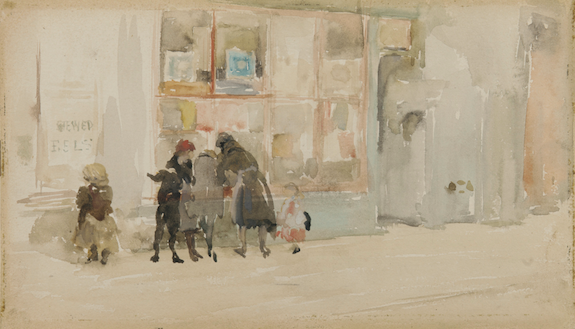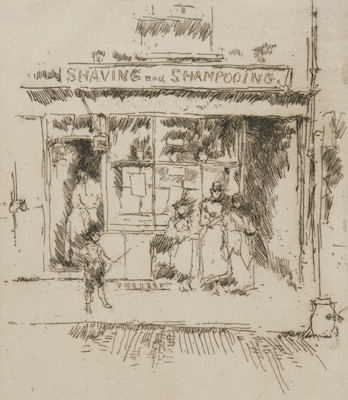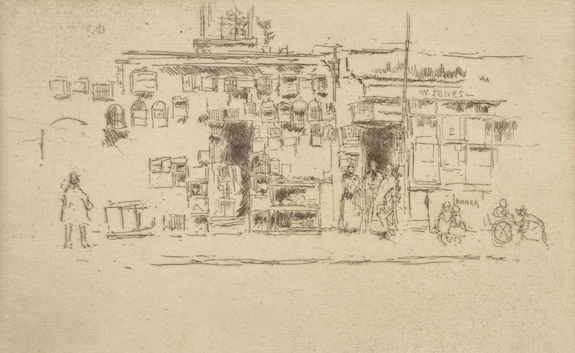Take a Stroll Through Whistler’s London Neighborhood
A handful of Whistler’s etchings, many never-before exhibited and on view at the Freer, offer a view of the artist’s Chelsea neighborhood
![]()

Children feature prominently in Whistler’s street scenes. Chelsea Children by James McNeill Whistler, Mid-1880s. Watercolor on paper. Courtesy the Freer Gallery.
The summer of 1858 was a bad time for London. Known as the Great Stink, the season’s warm temperatures worked a foul magic on the overflowing sewage situation. Thanks to the untenable stench, a bill rushed through Parliament in just 18 days funded a massive public works project known as the Thames Embankment.
The waterways improvement system forever reshaped the neighborhoods along the river, including Chelsea. The poor neighborhood subject to constant flooding was also a magnet for artists, including Oscar Wilde, John Singer Sargent and James McNeill Whistler. Whistler’s moody Nocturne paintings of the waterfront are well-known, but the Freer Gallery is offering fans of the ex-pat artist a chance to see the artist’s intimate neighborhood etchings of his daily wanderings and observations in the new exhibition, “Whistler’s Neighborhood: Impressions of a Changing London.”
The continuing effects of the Industrial Revolution and of the Embankment project meant Whistler worked at the edge of modernity and watched not just a neighborhood transform, but an entire society. Gone are the days of the Great Stink and the rag shops in Chelsea. But through thoughtful curation, viewers can once again walk the streets of Whistler’s neighborhood.

Storefronts offered up scenes of daily life. Shaving and Shampooing by James McNeill Whistler, ca. 1886-1888. Etching on paper. Courtesy the Freer Gallery.
“He would walk around his neighborhood and carry these small copper plates in his pocket,” explains the show’s curator Maya Foo. “These are really just quick impressions of street scenes. Many of the streets in this neighborhood were some of the poorest in all of London.”
The show includes 14 etchings, two water colors which will be shown separately for six months at a time and two oil paintings, all drawn from the streets of Chelsea around the 1880s. Completed in 1874, the embankment increased the value of property along the Thames and began a wave of transformation that Londoners were acutely aware of, fearing the loss of the city’s unique character. Without intending to, says Foo, Whistler captured transient moments in a changing landscape.
Fish shops, rag stores and fruit vendors populate his images, along with handfuls of untended young children. “He became a sort of unintentional recorder of a lot of these social issues that were going on at the time, such as overcrowding,” Foo says.
Through the addition of a detailed historical map and modern photographs of the streets, Foo hopes to show viewers that these storefronts were simply snippets of Whistler’s daily life. “I have loved figuring out where these places actually were on the map,” Foo says, citing foundational research done by Margaret MacDonald for the catalogue, James McNeill Whistler: The Etchings, a Catalogue Raisonné. Viewers are invited to do the same on a large map at the center of the exhibit space or online with a fascinating interactive feature.
The etchings were likely never intended to be displayed. Many were only reproduced three or four times. They are instead, says Foo, studies in geometry and form. “You’ll notice a lot of repetitions of dark doorways, glass windowpanes that kind of create a grid and, in a lot of these, he leaves the foreground empty so you get a sense of recession.”

Architectural details gave Whistler an opportunity to contemplate composition. Bird-cages, Chelsea by James McNeill Whistler, ca. 1886-1888. Etching on paper. Courtesy the Freer Gallery.
The brisk, staccato lines of the etchings contrast with the almost abstracted paintings of the Thames, some of which are on view upstairs in the Freer. Foo says, within the etchings, “There’s so much energy, it kind of relates to the modern city life that he was capturing as well.”
“I think fans of Whistler will find these to be a breath of fresh air because most of these etchings have never before been exhibited,” says Foo. “Usually when you think of Whistler, you think of the scenes down by the wharfs in Chelsea, the ships with their masts. But with these, this shows how he turned his back to the Thames and looked more at his neighborhood.”
“Whistler’s Neighborhood: Impressions of a Changing London” runs September 8, 2012 to September 8, 2013.
/https://tf-cmsv2-smithsonianmag-media.s3.amazonaws.com/accounts/headshot/Leah-Binkovitz-240.jpg)
/https://tf-cmsv2-smithsonianmag-media.s3.amazonaws.com/accounts/headshot/Leah-Binkovitz-240.jpg)